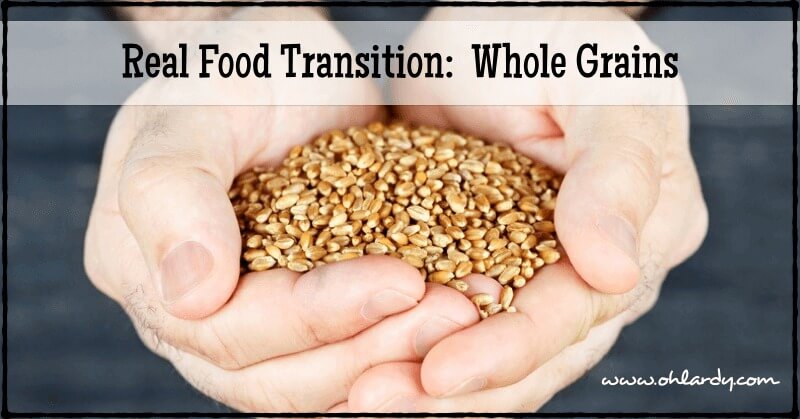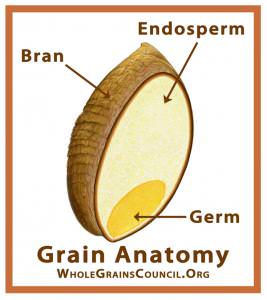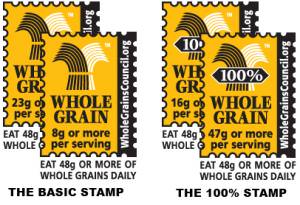Real Food Transition: Whole Grains
Oh Lardy! is a participant in the Amazon Services LLC Associates Program, an affiliate advertising program designed to provide a means for us to earn fees by linking to Amazon.com and affiliated sites.

When transitioning to a Real Food lifestyle, it is important to learn about the difference between whole and refined grains and how to find whole grains at the store. The Standard American Diet is chock full of refined grains that are essentially treated like sugar in the body. And while not everyone tolerates or chooses to eat grains, for people who do, whole grains can make up a very healthy part of the diet.
There is such a variety of whole grains out there; we never have to get bored with what we are eating. We all probably know about brown rice, whole wheat (more on wheat in another post), oats and, possibly, quinoa. Well I have made it a goal this year to start experimenting with grains that are new to me. It has been fun and a learning experience! I love the fact that I am finding new ways to add healthy foods to my family's diet.
What exactly is a ‘whole grain'
Whole grains are the seeds of grasses that we cultivate for food. Whole grains contain all the parts and nutrients that naturally occur in the seed. This definition means that 100% of the original seed – all of the bran, germ, and endosperm – must be present to qualify as a whole grain. Refined grains are milled and have the bran and germ removed. In turn, this removes many of the nutrients of the grain.
Benefits of whole grains
There are many health benefits to eating whole grains. They are a good source of B vitamins, Vitamin E, fiber, iron, manganese and selenium. They also provide some protein as well. They are digested slowly and so can provide sustained energy. Also, because whole grains contain bran and fiber, they help keep your bowels moving and your colon clean.
What whole grains are not
Refined Grains.
Refined grains are grains that have been processed and stripped of the bran and the germ. Refined grains have lost many of their nutrients. White flour, wheat flour (not whole wheat), white rice are examples of refined grains. Most packaged food items contain refined grains.
Enriched Grains.
Enriched grains are simply refined grains that have had some of the nutrients added back…or grains that have been ‘enriched' with nutrients. This is to make up for the nutrients removed during refining process. Many experts say these ‘added' nutrients are not as easily absorbed by our bodies as the nutrients that are naturally occurring.
Multigrain.
This one is tricky. It can mean a combination of whole grains and refined grains, a mix of all whole grains or a mix of all refined grains. You have to read the ingredient labels to see what grains actually make up ‘multigrain'.
How to find whole grains
Many whole grains can be found at your grocery store. Look by the rice, the pasta, the bulk aisle…even the gluten free aisle. You can also find flours made from these whole grains. Many products are available online.
When buying packaged/processed foods, don't be fooled by the terms ‘wheat' or ‘multigrain…you may be getting the whole grain, but often times you are not. In the US, if you see the words ‘whole wheat', ‘whole grain', ‘oats', ‘whole (other grain)', ‘wheatberries' and ‘brown rice', these mean you are getting all parts of the grain.
The Whole Grain Council has a handy stamp that is often present on foods containing whole grains. If you see the one with the 100% whole grains you can be sure that the grains in the product are ALL whole. If you see the basic whole grains stamp, you can be sure that there are SOME whole grains are present. I, personally, look for the 100% stamp.
Types of whole grains
There are many different types of whole grains. I am still learning to incorporate many of these into our diet. It has been fun to experiment with ‘new to me' grains. Each grain has a different nutritional profile and I would love to go in depth here. I will save that for another post. If you'd like more information about each grain, the Whole Grain Council has a wonderful A-Z explanation page.
Here is a partial list of whole grains:
- amaranth*
- barley
- bulgur
- corn*
- cornmeal (polenta) *
- farro
- kamut
- millet*
- quinoa*
- rye berries
- spelt
- teff*
- wheat berries
- brown rice*
- wild rice*
- whole oats**
- buckwheat (kasha)*
Soaking and sprouting whole grains
You may have heard about soaking or properly preparing grains. I think this is important, but I also think it is a ‘next step' for someone just starting out. If you are new to real food, the idea of soaking grains may seem like one more hassle in the kitchen. As you get used to incorporating whole foods in your diet, soaking can easily be implemented without too much of a headache.
Properly preparing whole grains by soaking is important because grains contain numerous anti-nutrients such as phytic acid and enzyme inhibitors. These are part of the plant's natural protection mechanism…they prevent the seed from sprouting until conditions are right. Unfortunately, phytic acid can be problematic because it binds to magnesium, copper, iron, zinc and calcium, blocking their absorption by the body.
Soaking grains neutralizes phytic acid and lessens the enzyme inhibitors. To soak grains, you simply soak them in room temperature water overnight, sometimes with the addition of an acidic medium (lemon juice, vinegar, whey), rinse and then cook. This releases the phytic acid and makes the grains more digestible. Soaking also activates the enzyme phytase, which reduces or eliminates the phytic acid.
Soaking grains also starts to predigest them, breaking down the complex sugars and starches, even starting to break down the proteins. This makes them much easier to digest and absorb by your body.
A couple of side notes, I have read that buckwheat or kasha gets mushy when soaked. I have not tried this yet. I also soak oats for oatmeal but I do not rinse. I feel the phytase activated is plenty to eliminate the phytic acid present in the oats. What are your thoughts and experiences?
Sprouting takes soaking to the next level as you actually let the seed start to germinate. I do not sprout very often. I occasionally buy sprouted wheat breads and flours for my kitchen.
Some recipes to get you started with whole grains
Many of these grains may be new to you. Here are some yummy recipes to get you started with your whole grain experiments! Enjoy!
- Black Bean Mango Quinoa Salad (my favorite summer salad)
- Quinoa Blueberry Mini Loaves
- Breakfast Millet with Prunes
- Roasted Onions Stuffed with Curried Black Quinoa
- Autumn Millet Bake
- Oh Lardy's Soaked Oatmeal
- Amaranth Tabbouleh
- Buckwheat Porridge
- Crunchy Honey Sweetened Buckwheat
- Beef and Bulgur Kabobs
So how about it…are you going to try some ‘new to you' whole grains? It opens up a whole new world in your kitchen! Good luck and I'd love to hear about your experiences in the kitchen with whole grains!
Pin It!
Sources:
Whole Grain Council
Mayo Clinic
Weston A. Price Foundation
Whole Grain Council
Shared at these awesome blog carnivals: Real Food Wednesday, Frugal Days Sustainable Ways, Party Wave Wednesday, Wildcrafting Wednesday, Simple Lives Thursday, Thank Your Body Thursday, Tasty Traditions, Simple Meals Friday, Old Fashioned Friday, Weekend Whatever, Sunday School, Make Your Own Monday, More the Merrier Monday, Homestead Barn Hop, Thank Goodness It's Monday




Thank you for the wonderful info on whole grains. I truly had no idea there were different stamps for whole grains. Very interesting.
Brown rice should be soaked overnight too? I never knew that.
This post is a keeper. Keep sharing please.
Thank you so much! Yes, brown rice should also be soaked. Sometimes I forget, to be honest, and don’t soak. We are having rice tonight and I forgot and am soaking now. It will get at least a good 6 hours in. I add raw apple cider vinegar or whey to the soaking water. Then rinse and cook with either water or bone broth. Glad you enjoyed the post!!
When I originally commented I clicked the “Notify me when new comments are added” checkbox and
now each time a comment is added I get several e-mails with the same comment.
Is there any way you can remove people from that service?
Many thanks!
There should be a clickable link in the bottom of those emails that says to stop getting notifications. Let us know if you still have trouble!
Thanks for sharing this on the home sweet home link party I learned a ton from it! I feel like I have a much better understanding
Susan
Thank you so much!!
I’ve been experimenting with trying different grains too. Recently I’ve tried using buckwheat and millet. It’s fun to try out different options than the standard wheat 🙂
Thanks for sharing with Old-Fashioned Friday!
Great post! So should all the grains listed above be soaked over night? Which ones need the acid addition? Thanks!
You can soak any of the grains. I have heard kasha gets mushy though. Any soaking should have the acidic medium (lemon juice, whey, vinegar) added.
Good luck!
Lovely post, great information here! Here’s my recipe for Rye Berry Salad (with recipe video!) that I like to make by soaking the grains according to the Nourishing Traditions method: http://kitchenvignettes.blogspot.com/2012/09/rye-berry-salad.html
Looks awesome!!! Thanks for sharing